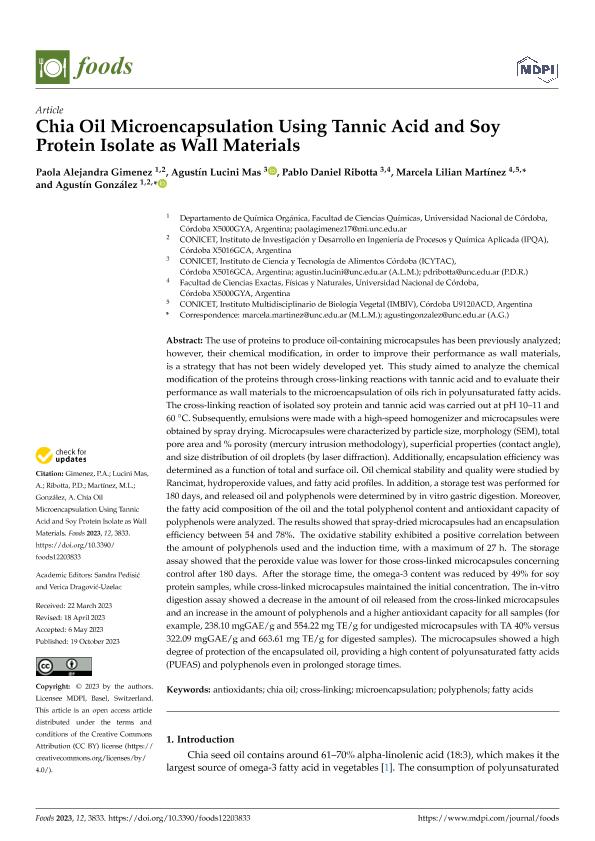Mostrar el registro sencillo del ítem
dc.contributor.author
Giménez, Paola Alejandra
dc.contributor.author
Lucini Mas, Agustín

dc.contributor.author
Ribotta, Pablo Daniel

dc.contributor.author
Martinez, Marcela Lilian

dc.contributor.author
González, Agustín

dc.date.available
2024-01-25T15:22:03Z
dc.date.issued
2023-06
dc.identifier.citation
Giménez, Paola Alejandra; Lucini Mas, Agustín; Ribotta, Pablo Daniel; Martinez, Marcela Lilian; González, Agustín; Chia Oil Microencapsulation Using Tannic Acid and Soy Protein Isolate as Wall Materials; Multidisciplinary Digital Publishing Institute; Foods; 12; 20; 6-2023; 1-15
dc.identifier.uri
http://hdl.handle.net/11336/224884
dc.description.abstract
The use of proteins to produce oil-containing microcapsules has been previously analyzed; however, their chemical modification, in order to improve their performance as wall materials, is a strategy that has not been widely developed yet. This study aimed to analyze the chemical modification of the proteins through cross-linking reactions with tannic acid and to evaluate their performance as wall materials to the microencapsulation of oils rich in polyunsaturated fatty acids. The cross-linking reaction of isolated soy protein and tannic acid was carried out at pH 10–11 and 60 °C. Subsequently, emulsions were made with a high-speed homogenizer and microcapsules were obtained by spray drying. Microcapsules were characterized by particle size, morphology (SEM), total pore area and % porosity (mercury intrusion methodology), superficial properties (contact angle), and size distribution of oil droplets (by laser diffraction). Additionally, encapsulation efficiency was determined as a function of total and surface oil. Oil chemical stability and quality were studied by Rancimat, hydroperoxide values, and fatty acid profiles. In addition, a storage test was performed for 180 days, and released oil and polyphenols were determined by in vitro gastric digestion. Moreover, the fatty acid composition of the oil and the total polyphenol content and antioxidant capacity of polyphenols were analyzed. The results showed that spray-dried microcapsules had an encapsulation efficiency between 54 and 78%. The oxidative stability exhibited a positive correlation between the amount of polyphenols used and the induction time, with a maximum of 27 h. The storage assay showed that the peroxide value was lower for those cross-linked microcapsules concerning control after 180 days. After the storage time, the omega-3 content was reduced by 49% for soy protein samples, while cross-linked microcapsules maintained the initial concentration. The in-vitro digestion assay showed a decrease in the amount of oil released from the cross-linked microcapsules and an increase in the amount of polyphenols and a higher antioxidant capacity for all samples (for example, 238.10 mgGAE/g and 554.22 mg TE/g for undigested microcapsules with TA 40% versus 322.09 mgGAE/g and 663.61 mg TE/g for digested samples). The microcapsules showed a high degree of protection of the encapsulated oil, providing a high content of polyunsaturated fatty acids (PUFAS) and polyphenols even in prolonged storage times.
dc.format
application/pdf
dc.language.iso
eng
dc.publisher
Multidisciplinary Digital Publishing Institute
dc.rights
info:eu-repo/semantics/openAccess
dc.rights.uri
https://creativecommons.org/licenses/by/2.5/ar/
dc.subject
ANTIOXIDANTS
dc.subject
CHIA OIL
dc.subject
CROSS-LINKING
dc.subject
FATTY ACIDS
dc.subject
MICROENCAPSULATION
dc.subject
POLYPHENOLS
dc.subject.classification
Recubrimientos y Películas

dc.subject.classification
Ingeniería de los Materiales

dc.subject.classification
INGENIERÍAS Y TECNOLOGÍAS

dc.title
Chia Oil Microencapsulation Using Tannic Acid and Soy Protein Isolate as Wall Materials
dc.type
info:eu-repo/semantics/article
dc.type
info:ar-repo/semantics/artículo
dc.type
info:eu-repo/semantics/publishedVersion
dc.date.updated
2024-01-16T13:56:18Z
dc.identifier.eissn
2304-8158
dc.journal.volume
12
dc.journal.number
20
dc.journal.pagination
1-15
dc.journal.pais
Suiza

dc.journal.ciudad
Basilea
dc.description.fil
Fil: Giménez, Paola Alejandra. Universidad Nacional de Córdoba. Instituto de Investigación y Desarrollo en Ingeniería de Procesos y Química Aplicada. Consejo Nacional de Investigaciones Científicas y Técnicas. Centro Científico Tecnológico Conicet - Córdoba. Instituto de Investigación y Desarrollo en Ingeniería de Procesos y Química Aplicada; Argentina. Universidad Nacional de Córdoba. Facultad de Ciencias Químicas; Argentina
dc.description.fil
Fil: Lucini Mas, Agustín. Consejo Nacional de Investigaciones Científicas y Técnicas. Centro Científico Tecnológico Conicet - Córdoba. Instituto de Ciencia y Tecnología de Alimentos Córdoba. Universidad Nacional de Córdoba. Facultad de Ciencias Químicas. Instituto de Ciencia y Tecnología de Alimentos Córdoba; Argentina
dc.description.fil
Fil: Ribotta, Pablo Daniel. Consejo Nacional de Investigaciones Científicas y Técnicas. Centro Científico Tecnológico Conicet - Córdoba. Instituto de Ciencia y Tecnología de Alimentos Córdoba. Universidad Nacional de Córdoba. Facultad de Ciencias Químicas. Instituto de Ciencia y Tecnología de Alimentos Córdoba; Argentina. Universidad Nacional de Córdoba. Facultad de Ciencias Exactas, Físicas y Naturales; Argentina
dc.description.fil
Fil: Martinez, Marcela Lilian. Consejo Nacional de Investigaciones Científicas y Técnicas. Centro Científico Tecnológico Conicet - Córdoba. Instituto Multidisciplinario de Biología Vegetal. Universidad Nacional de Córdoba. Facultad de Ciencias Exactas Físicas y Naturales. Instituto Multidisciplinario de Biología Vegetal; Argentina. Universidad Nacional de Córdoba. Facultad de Ciencias Exactas, Físicas y Naturales; Argentina
dc.description.fil
Fil: González, Agustín. Universidad Nacional de Córdoba. Instituto de Investigación y Desarrollo en Ingeniería de Procesos y Química Aplicada. Consejo Nacional de Investigaciones Científicas y Técnicas. Centro Científico Tecnológico Conicet - Córdoba. Instituto de Investigación y Desarrollo en Ingeniería de Procesos y Química Aplicada; Argentina. Universidad Nacional de Córdoba. Facultad de Ciencias Químicas; Argentina
dc.journal.title
Foods
dc.relation.alternativeid
info:eu-repo/semantics/altIdentifier/url/https://www.mdpi.com/2304-8158/12/20/3833
dc.relation.alternativeid
info:eu-repo/semantics/altIdentifier/doi/http://dx.doi.org/10.3390/foods12203833
Archivos asociados
